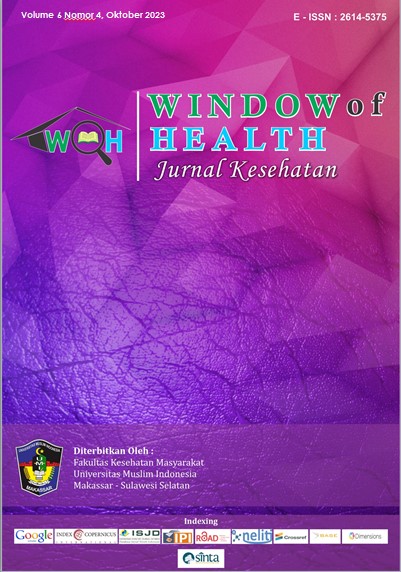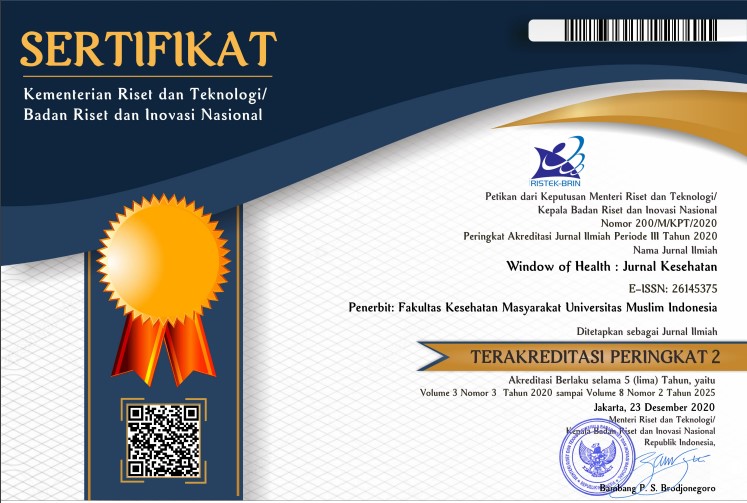Correlation Between Health Belief Model on Early Mobilization Behavior during the Postpartum Period in Jember Regency
Abstract
Maternal mortality is still a major public health problem. Every day, about 810 women around the world die cause of related to pregnancy, childbirth, and puerperium. Jember Regency has the highest number of maternal deaths in East Java in 2021, namely 115 deaths, of which 61 (53%) occurred during the puerperium. This study aims to determine the relationship between the health belief model and early mobilization behavior during the postpartum period in the Jember District. The health belief model consists of perceived susceptibility, perceived severity, perceived benefits, and perceived barriers. Research with a cross-sectional design was conducted on 123 postpartum mothers in the Jember Regency. A multistage random sampling technique was used to sample the population. Data were collected through questionnaires and observation checklists of mobilization behavior, then analyzed using descriptive data analysis and the Spearman correlation test. The results of the descriptive data analysis showed that 86.2% of postpartum mothers were aged 20-35 years, and 40.7% had a high school level of education. In comparison, the results of the Spearman correlation test showed perceived susceptibility (p=0.000, ρ = 0.346), perceived severity (p=0.001, ρ = 0.309), perceived benefits (p=0.000, ρ = 0.450) and perceived barriers (p=0.000, ρ = -0.428). It can be concluded that perceptions of susceptibility, severity, and benefits have a positive relationship with early mobilization behavior, while perceived barriers have a negative relationship. It is necessary to strengthen community and family empowerment efforts by increasing the role of cadres and families in providing motivation and support to postpartum mothers to carry out early mobilization to prevent complications during the postpartum period and to accelerate recovery in postpartum mothers after giving birth.
References
Elkhoudri N, Amor H, Baali A. Self-reported postpartum morbidity : prevalence and determinants among women in Marrakesh , Morocco. Reprod Health. 2015;12(75):1–5.
WHO. Maternal mortality Evidance brief [Internet]. Geneva: Department of Reproductive Health and Research World Health Organization; 2019. 1–4 p. Available from: https://apps.who.int/iris/bitstream/handle/10665/329886/WHO-RHR-19.20-eng.pdf?ua=1
WHO. World Health Statistics 2021, Monitoring Health For The SDGs. Vol. 4. 2021. 6 p.
Tikkanen R, Gunja MZ, FitzGerald M, Zephyrin L. Maternal Mortality and Maternity Care in the United States Compared to 10 Other Developed Countries. The Commonwealth Fund. 2020.
Say L, Chou D, Gemmill A, Tunçalp Ö, Moller AB, Daniels J, et al. Global causes of maternal death: A WHO systematic analysis. Lancet Glob Heal. 2014;2(6):323–33.
Dinkes Jawa Timur. Profil Kesehatan 2021. Dinas Kesehatan provinsi Jawa Timur; 2022.
Ahmed S, Fullerton J. Challenges of reducing maternal and neonatal mortality in Indonesia: Ways forward. Int J Gynecol Obstet. 2019;144(1):1–3.
Dewi R. The Relationship of Normal Postpartum Mother Knowledge and. Sci Midewifery. 2020;9(1):19–23.
Susanti S, Sari IN. Early Mobilization Behavior of Mother Post Section Caesarea At Embung Fatimah Hospital Batam City. Int J Nurs Midwifery Sci. 2022;6(1):82–7.
Mahishale A V., Ulorica LPAM, Patil HS. Effect of postnatal exercises on quality of life in immediate postpartum mothers: A clinical trial. J SAFOG. 2014;6(1):11–4.
Kaur MR, Sharma K, Joshi MU. A Quasi-Experimental Study to Assess the Effectiveness of Early Ambulation on Involution of Uterus among Postnatal Mothers Admitted At SGRD Hospital, Vallah, Sri Amritsar, Punjab. Int J Heal Sci Res [Internet]. 2017;7(10):165. Available from: www.ijhsr.org
Roheman, Seventina H, Mustopa, Masrifah, Wike. Effect of Early Mobilization on the Decrease in Pain Intensity Among Post Cesarean Section Patients at Cirebon Hospital in 2019. Proc 1st Int Conf Sci Heal Econ Educ Technol. 2020;27(ICoSHEET 2019):382–4.
Cholifah N, Siswanti H. Factors Related to the Speed of the Uterus Involution in Post Partum Mothers. In: International Conference on Public Health. 2021. p. 862–7.
Anifah F. Relationship between early mobilization and first. In: International Conference on Applied Science and Health. 2017. p. 198–203.
Paul R, Narayan PJP, Kaur H. Effectiveness of Early Ambulation on Post Operative Recovery among the Women with Caesarean Section CS. Int J Trend Sci Res Dev. 2019;Volume-3(Issue-3):851–5.
Abraham C, Sheeran P. The health belief model. Cambridge Handbook of Psychology, Health and Medicine, Second Edition. 2014. 97–102 p.
Zar’in AU, Arovah NI. Physical Activities and Construct of Health Belief Models in the Special Region of Yogyakarta in the Era of Pandemy Covid-19. Budapest Int Res Critics Linguist Educ J. 2021;4(2):698–709.
Berhimpong MJA, Rattu AJM, Pertiwi JM. Analisis Implementasi Aktivitas Fisik Berdasarkan Health Belief Model oleh Tenaga Kesehatan di Puskesmas. J Public Heal Community Med. 2020;1(4):54–62.
Paryab F, Ghanjal A, Tavakkoli R. The effect of education based on health belief model on postpartum exercise in primiparous women. J Adv Pharm Educ Res. 2018;8(2):179–83.
Mohammad S, Hazavehie M, Lotfinik Z, Moeini B, Roshanaei G. The effect of education based on health belief model on postpartum care in pregnant women. J Res Heal. 2018;8(4):382–91.
Kemenkes RI. Peraturan Menteri Kesehatan republik Indonesia Nomor 21 Tahun 2021 Penyelenggaraan Pelayanan Kesehatan Masa Sebelum Hamil, Masa Hamil, Persalinan, Dan Masa Sesudah Melahirkan, Pelayanan Kontrasepsi, Dan Pelayanan Kesehatan Seksual. 2021 p. 1–184.
Kemenkes RI. Buku KIA 2020. Kementerian Kesehatan RI. Jakarta: Kementrian Kesehatan Republik Indonesia; 2020. p. 1–53.
Dinkes Jawa Timur. Profil Kesehatan Provinsi Jawa Timur. surabaya; 2021.
Sugiyono. Metode Penelitian Kuantitatif, Kualitatif, dan R&D. Bandung: CV Alfabeta; 2017.
Seungmi P, Deulle M, Jiyeon P. The Influence of Knowledge and Health Beliefs about Gestational Diabetes on Breastfeeding Intention of Women with Gestational Diabetes. J Korean Acad Community Heal Nurs. 2020;31(4):427–35.
Parsa P, Masoumi Z, Parsa N, Parsa B. Parents’ health beliefs influence breastfeeding patterns among Iranian women. Oman Med J. 2015;30(3):187–92.
Loke AY, Davies L, Li SF. Factors influencing the decision that women make on their mode of delivery: The Health Belief Model. BMC Health Serv Res. 2015;15(1):1–12.
Myers RE, Tilley BC. Colorectal Cancer Screening Intention and. Ann Behav Med. 2010;40(2):205–17.
Leung Y. Perceived Benefits. In: Gellman, Turner, editors. Encyclopedia of Behavioral Medicine [Internet]. Springer, New York; 2013. Available from: https://doi.org/10.1007/978-1-4419-1005-9_1165
Anggraeni FD, Putriningrum E. Hubungan perceived susceptibilit y dan perceived benefits dengan pemberian ASI eksklusif pada balita di Puskesmas Kasihan I Bantul The relationship between perceived susceptibility and perceived benefits with exclusive breastfeeding for toddlers in Kasiha. Media Ilmu Kesehat. 2021;10(2):140–5.
Saligheh M, McNamara B, Rooney R. Perceived barriers and enablers of physical activity in postpartum women: A qualitative approach. BMC Pregnancy Childbirth [Internet]. 2016;16(1):1–8. Available from: http://dx.doi.org/10.1186/s12884-016-0908-x
Alshahrani AM, Abdullah AM, Elgzar WT, Ibrahim HA, Eltohamy NA. Postnatal exercises: Perceived barriers and self-efficacy among women at maternal and children hospital at najran, Kingdom of Saudi Arabia. Afr J Reprod Health. 2020;24(4):164–72.
Rahayu IS, Mudatsir, Hasballah. Faktor Budaya Dalam Perawatan Ibu Nifas. J Ilmu Keperawatan. 2017;5(1):36–49.
Diaz-Quijano FA, Martínez-Vega RA, Rodriguez-Morales AJ, Rojas-Calero RA, Luna-González ML, Díaz-Quijano RG. Association between the level of education and knowledge, attitudes and practices regarding dengue in the Caribbean region of Colombia. BMC Public Health. 2018;18(1):1–10.
Nooriani N, Mohammadi V, Feizi A, Shahnazi H, Askari G, Ramezanzade E. The effect of nutritional education based on health belief model on nutritional knowledge, Health Belief Model constructs, and dietary intake in hemodialysis patients. Iran J Nurs Midwifery Res. 2019;24(5):372–8.
Naghashpour M, Shakerinejad G, Lourizadeh MR, Hajinajaf S, Jarvandi F. Nutrition education based on health belief model improves dietary calcium intake among female students of junior high schools. J Heal Popul Nutr. 2014;32(3):420–9.
Copyright (c) 2023 Nurul Aini

This work is licensed under a Creative Commons Attribution-NonCommercial-ShareAlike 4.0 International License.








